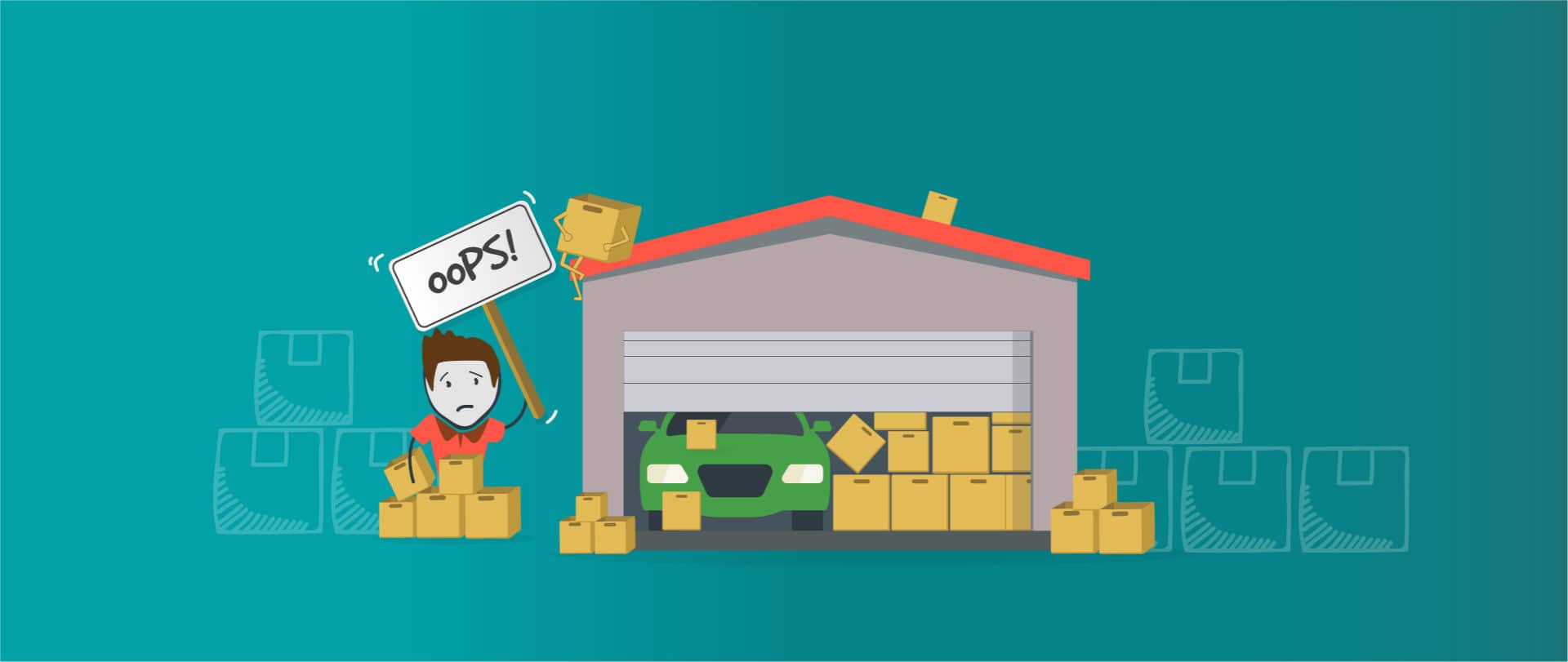8 Things That Could Go Wrong with In-House Fulfillment
If you’re shipping your own products or considering whether to hire a third-party fulfillment center, there are many factors to consider. In-house fulfillment requires a keen eye on many moving parts. The ramifications of even one step in your fulfillment process breaking down can directly affect your brand – and every department within your organization.
If you’ll be managing your own fulfillment process, watch out for these 9 things that could go wrong with in-house fulfillment.
1. A sharp increase in order volume.
You may be wondering if you’re reading this correctly. Yes, a sharp increase in order volume is actually something that could go wrong if you’re fulfilling orders in-house.
Let me tell you a story… A friend of mine owns an international distribution company that sells a very niche line of products made by various manufacturers. His company had been doing well for a while and was steadily shipping about 100 orders per day out of their own warehouse. One day, my friend signed a contract for a lucrative partnership with a new brand. He secured exclusive rights to distribute that brand’s new product within the United States. The new brand ran a heavily marketed ad campaign for the launch of the new product, and my friend’s company also had a large following of customers who were intrigued by a new niche product, so the pre-order campaign launched to massive success. My friend’s business boomed overnight. They woke up to 3 times their normal sales order volume. Sounds great, right? It was!
Except… while they welcomed a sharp increase in revenue, they weren’t prepared for such a sharp increase in fulfillment. The pre-orders kept piling up in their system and, soon after, the product landed in their warehouse and it was time to ship orders out to antsy customers. All of a sudden, my friend’s company had to fulfill thousands of pre-orders to retail customers across the United States. The fulfillment process was instantly behind schedule. With only a week’s notice, they hadn’t prepared for such a huge workload – and they didn’t have time to hire and train enough new warehouse workers. It was impossible for them to ship products on time.
And then… hundreds of emails started coming in asking about delivery dates and complaining about late shipments. After a weekend off, my friend’s three-person customer service team woke up to thousands of new emails on a Monday. Battling a bursting inbox and consoling upset customers meant all hands on deck, working weekends, increasing hours, and dedicating staff just to emails (which meant missed calls and longer wait time on phones). My friend even incentivized his customer service team with a hefty cash bonus if they worked overtime on the weekend and managed to achieve inbox zero (i.e. zero emails left in the inbox). Worse yet, it resulted in refunding many unhappy customers who paid extra for expedited shipping (which meant the company took a double loss – paying for the expedited shipping and the customer refund).
In the end… my friend’s company finally got back on their feet and they were able to satisfy most of their loyal customers. But it cost the company a veritable ton of time – and way too much money – to get back in good standing with their daily processes and renew the faith of their customers. Ultimately, what went wrong in the fulfillment process also heavily affected their customer service team and their marketing department. And it could’ve cost them their reputation if my friend’s team hadn’t stepped up to the plate as driven and motivated as they did!
2. Slow or late order shipments.
Ultimately, if you’re having trouble getting your products out the door and into the hands of your customers quickly, your business is going to suffer. As mentioned in #1, a sudden increase in order volume – such as seasonal fluctuations in demand – can cause a bottleneck in fulfillment operations.
If you’re only selling a few products per day, in-house fulfillment is probably your best bet – but if you’re focusing on marketing your business and more people begin to discover your products, then a sharp increase to a few dozen orders per day can mean late shipments if you’re not prepared. This can turn into unsatisfied customers and negative online reviews of your brand.
Other times, slow or late order fulfillment can be caused by employees taking unexpected sick time or staff members going on vacation. This can cause trouble for your customer service team (compounding the effect and increasing the cost to you).
3. Lack of expertise.
In your day-to-day responsibilities, this might look like:
-
- Wearing “too many hats” (i.e. you or another team member fulfilling too many non-specific roles).
-
- Having to learn on the job and find solutions to new and unexpected problems.
- Taking time away from more important things that only you can do.
We’re guessing you didn’t start your product-based company because you were hoping to become a fulfillment logistics expert. If you’re not interested in specializing in fulfillment – or if your time is better spent on other business activities – you’ll want a fulfillment logistics specialist on your team.
Without having a skilled leader informing your fulfillment plan, your logistics can easily become outdated or suffer from inefficiencies that are hard to pinpoint. A fulfillment partner can be a key relationship when looking to grow and scale a business. After all, the more successful your company is, the more successful the fulfillment center is; so, the right fulfillment company is invested in your growth and ultimate success. It’s smart to focus on your core competencies. How is your time best spent? How is your employees’ time best spent?
4. Mistakes or delays in receiving inventory.
Without skilled specialists at the helm of your fulfillment process, silly mistakes can occur such as improperly receiving inventory into your system.
Furthermore, if your warehouse team is getting backed up in order fulfillment they may postpone the task of receiving new inventory into the system – leaving valuable inventory sitting on pallets and clogging up your warehouse. At times like this, your warehouse manager (which may be you) has to make a difficult decision: Should we postpone receiving these new pallets into the system – or should we do it now and risk not getting all of today’s orders shipped out on time?
5. Turnover, and training new hires or seasonal employees.
Turnover is no fun for anyone, but it’s a fact of business. Every time someone quits or is fired, they’ll need to be replaced. This means more time and money spend on the hiring process and the new hire’s training. But you may think it’s just part of the process; after all, you need enough people to pick, pack, receive, replenish, and manage inventory.
Similarly, if you’re hiring new team members in preparation for a busy season (such as the holiday rush between November through January), you’re using resources hiring and training staff members that probably won’t be around for long. This can prove extremely inefficient because you may have to let these workers go – just when they were really getting good at their work! In-house staff also adds responsibility to your company in terms of payroll, management, and even performance reviews.
6. Inefficiencies.
This one is purposefully broad, as there are countless ways a company can experience inefficiencies that cause more things to go wrong with in-house fulfillment.
Some examples include:
-
- Employee mistakes and the retraining process.
-
- Over-purchasing or overpaying for supplies (packing material, boxes, tape, labels) due to low order volume and minimum order quantities.
-
- Overpaying for shipping due to improper dimensional weight.
-
- Replacing products damaged in transit due to poorly packed boxes.
-
- Overpaying for labor (slow, inefficient, non-expert workers)
-
- Spending too much time receiving, managing, picking, packing, and shipping orders (especially if you’re the one doing these tasks when you need to focus on what you and your business do best).
-
- Processing backorder items inefficiently.
- Lack of a warehouse management system (i.e. best of breed technologies)
It’s also very possible that you’re spending too much money on the overall fulfillment process. Determine your fulfillment cost-per order to compare the price of in-house fulfillment to outsourced fulfillment, including:
-
- Storage and facility costs;
-
- Labor costs;
-
- Packing material costs;
-
- Shipping costs; and
- YOUR TIME!
Another inefficiency to consider: If the location of your business is not in a prime location to ship from and to, this can cause high shipping rates and long transit times. This largely depends on where you mainly ship orders to. For example, if you are on the East Coast of the U.S. shipping everywhere in America, consider shipping from a warehouse more centrally located to lower your fulfillment cost-per-order (great for you) and speed up transit time (great for your customer).
7. Security issues.
If your technology isn’t advanced, you may be vulnerable to data breaches which can put at risk both your business and your customer’s information. Another security issue to look out for is stolen inventory (we hate to say it, but it’s too common without proper preventative efforts).
8. Running out of warehouse space.
Real estate is expensive. If you’re already paying more than you want to for a warehouse, think of how big of a hassle it would be to run out of space in your warehouse. Of course, you want your business to grow – yet you need to be prepared for the ramifications of growth, including needing more room for inventory. One big problem with in-house fulfillment is that companies lock themselves into a long-term leases that don’t allow flexibility because they didn’t accurately forecast their business needs.
What can you do to avoid problems with in-house fulfillment?
If you are unprepared for these possibilities (or if you’re already experiencing these difficult scenarios), consider hiring a fulfillment center. For more factors to think about, check out this article to determine when might be the right time to hire a fulfillment center.
And if you’re not yet at the stage of needing or wanting to outsource fulfillment to a third-party logistics company, we encourage you to enjoy the experience of being at your current stage of business. There is so much to learn about business and entrepreneurship through the eyes of the order fulfillment process. Your experience shipping your own packages today may one day be a fond memory in your company’s unique story.



